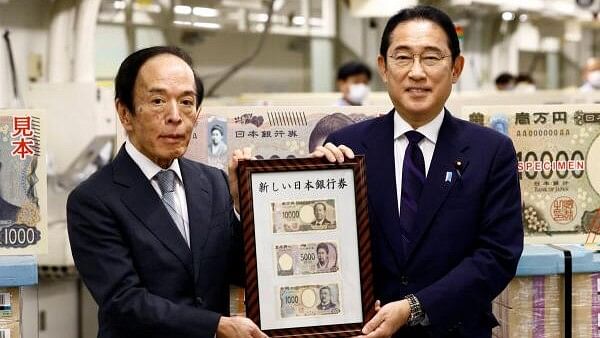
Japan's Prime Minister Fumio Kishida shows new banknotes with Bank of Japan (BOJ) Governor Kazuo Ueda, on the day of the new notes of 10,000 yen, 5,000 yen and 1,000 yen went into circulation, at the BOJ headquarters in Tokyo, Japan.
Credit: Reuters Photo
Tokyo: Japan began circulating its first new banknotes in 20 years on Wednesday, featuring three-dimensional portraits of the founders of financial and female education institutions in an attempt to frustrate counterfeiters.
The notes use printed patterns to generate holograms of the portraits facing different directions, depending on the angle of view, employing a technology that Japan's National Printing Bureau says is the world's first for paper money.
"Faces of those representing Japan's capitalism, women's empowerment and technology innovation are on the new bills," Prime Minister Fumio Kishida said at a function.
The step comes just as the economy moves into a growth-driven phase for the first time in three decades, he added.
Though existing bills stay in use, train stations, parking lots and ramen shops are scrambling to upgrade payment machines as the government pushes consumers and businesses to use less cash in its bid to digitise the economy.
The new 10,000-yen ($62) note depicts Eiichi Shibusawa (1840-1931), the founder of the first bank and stock exchange, who is often called "the father of Japanese capitalism".
The new 5,000-yen bill portrays educator Umeko Tsuda (1864-1929), who founded one of the first women's universities in Japan, while the 1,000-yen bill features a pioneering medical scientist, Shibasaburo Kitasato (1853-1931).
Currency authorities plan to print about 7.5 billion newly-designed bills by the end of the current fiscal year. They will add to the 18.5 billion banknotes worth 125 trillion yen already in circulation as of December 2023.
"Cash is a secure means of payment that can be used by anyone, anywhere, and at any time, and it will continue to play a significant role" despite alternatives, said Kazuo Ueda, the governor of the Bank of Japan.
The central bank has been conducting experiments on digital currencies, but the government has made no decision on whether to issue a digital yen.
'NO SALES IMPACT'
The first renewal of paper money since 2004 spurred businesses to upgrade payment machines for cash-loving customers.
Cashless payments in Japan have almost tripled over the past decade to make up 39 per cent of consumer spending in 2023, but still lag global peers and should rise to 80 per cent to boost productivity, the government says.
Roughly 90 per cent of bank ATMs, train ticket machines and retail cash registers are ready for the new bills, but only half of restaurant and parking ticket machines, the Japan Vending Machine Manufacturers Association said.
Nearly 80 per cent of the nations' 2.2 million drink vending machines also need upgrades, it added.
"It might take until year-end to respond to this," said Takemori Kawanami, an executive at ticket machine company Elcom. "That's too slow, but we are short of components," he added, as client orders for upgrades exceeded expectations.
Many Japanese fast-food restaurants such as ramen shops and beef bowl stores rely on ticket machines to cut labour costs, but some small business owners battling inflation are unhappy at the extra investment the new bills entail.
"The machine replacement has no sales impact, so it's only negative for us, on top of rising costs of labour and ingredients," said Shintaro Sekiguchi, who spent about 600,000 yen for ticket machines at three ramen shops he runs in Tokyo. ($1=161.6500 yen)